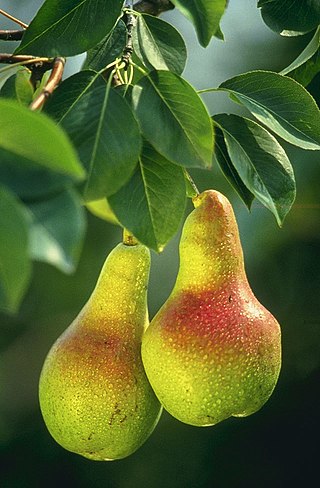
An island or isle is a piece of land, distinct from a continent, completely surrounded by water. There are continental islands, which were formed by being split from a continent by plate tectonics, and oceanic islands, which have never been part of a continent. Oceanic islands can be formed from volcanic activity, grow into atolls from coral reefs, and form from sediment along shorelines, creating barrier islands. River islands can also form from sediment and debris in rivers. Artificial islands are those made by humans, including small rocky outcroppings built out of lagoons and large-scale land reclamation projects used for development.

A mammal is a vertebrate animal of the class Mammalia. Mammals are characterized by the presence of milk-producing mammary glands for feeding their young, a broad neocortex region of the brain, fur or hair, and three middle ear bones. These characteristics distinguish them from reptiles and birds, from which their ancestors diverged in the Carboniferous Period over 300 million years ago. Around 6,400 extant species of mammals have been described and divided into 27 orders.

Pears are fruits produced and consumed around the world, growing on a tree and harvested in late summer into mid-autumn. The pear tree and shrub are a species of genus Pyrus, in the family Rosaceae, bearing the pomaceous fruit of the same name. Several species of pears are valued for their edible fruit and juices, while others are cultivated as trees.

A rose is either a woody perennial flowering plant of the genus Rosa, in the family Rosaceae, or the flower it bears. There are over three hundred species and tens of thousands of cultivars. They form a group of plants that can be erect shrubs, climbing, or trailing, with stems that are often armed with sharp prickles. Their flowers vary in size and shape and are usually large and showy, in colours ranging from white through yellows and reds. Most species are native to Asia, with smaller numbers native to Europe, North America, and Northwest Africa. Species, cultivars and hybrids are all widely grown for their beauty and often are fragrant. Roses have acquired cultural significance in many societies. Rose plants range in size from compact, miniature roses to climbers that can reach seven meters in height. Different species hybridize easily, and this has been used in the development of the wide range of garden roses.

The Himalayas, or Himalaya is a mountain range in Asia, separating the plains of the Indian subcontinent from the Tibetan Plateau. The range has several peaks exceeding an elevation of 8,000 m (26,000 ft) including Mount Everest, the highest mountain on Earth. The mountain range runs for 2,400 km (1,500 mi) as an arc from west-northwest to east-southeast at the northern end of the Indian subcontinent.

The Western Ghats, also known as the Sahyadri, is a mountain range that stretches 1,600 km (990 mi) along the western coast of the Indian peninsula. Covering an area of 160,000 km2 (62,000 sq mi), it traverses the states of Gujarat, Maharashtra, Goa, Karnataka, Kerala, and Tamil Nadu. The range forms an almost continuous chain of mountains along the western edge of the Deccan Plateau, from the Tapti River to Swamithoppe in Kanyakumari district at the southern tip of the Indian peninsula. The Western Ghats meet with the Eastern Ghats at Nilgiris before continuing south.

Bird migration is a seasonal movement of birds between breeding and wintering grounds that occurs twice a year. It is typically from north to south or from south to north. Migration is inherently risky, due to predation and mortality.
Cypress is a common name for various coniferous trees or shrubs from the Cupressus genus of the Cupressaceae family, typically found in warm-temperate and subtropical regions of Asia, Europe, and North America.

Agaricus bisporus, commonly known as the cultivated mushroom, is a basidiomycete mushroom native to grasslands in Eurasia and North America. It is cultivated in more than 70 countries and is one of the most commonly and widely consumed mushrooms in the world. It has two color states while immature – white and brown – both of which have various names, with additional names for the mature state, such as chestnut, portobello, portabellini, button and champignon de Paris.

The cherry blossom, or sakura, is the flower of trees in Prunus subgenus Cerasus. Sakura usually refers to flowers of ornamental cherry trees, such as cultivars of Prunus serrulata, not trees grown for their fruit. Cherry blossoms have been described as having a vanilla-like smell, which is mainly attributed to coumarin.

The Endangered Species Act of 1973 is the primary law in the United States for protecting and conserving imperiled species. Designed to protect critically imperiled species from extinction as a "consequence of economic growth and development untempered by adequate concern and conservation", the ESA was signed into law by President Richard Nixon on December 28, 1973. The Supreme Court of the United States described it as "the most comprehensive legislation for the preservation of endangered species enacted by any nation". The purposes of the ESA are two-fold: to prevent extinction and to recover species to the point where the law's protections are not needed. It therefore "protect[s] species and the ecosystems upon which they depend" through different mechanisms. For example, section 4 requires the agencies overseeing the Act to designate imperiled species as threatened or endangered. Section 9 prohibits unlawful 'take,' of such species, which means to "harass, harm, hunt..." Section 7 directs federal agencies to use their authorities to help conserve listed species. The Act also serves as the enacting legislation to carry out the provisions outlined in The Convention on International Trade in Endangered Species of Wild Fauna and Flora (CITES).

The dog is a domesticated descendant of the wolf. Also called the domestic dog, it was selectively bred from an extinct population of wolves during the Late Pleistocene by hunter-gatherers. The dog was the first species to be domesticated by humans, over 14,000 years ago and before the development of agriculture. Experts estimate that due to their long association with humans, dogs have gained the ability to thrive on a starch-rich diet that would be inadequate for other canids.

The Pyralinae are the typical subfamily of snout moths and occur essentially worldwide, in some cases aided by involuntary introduction by humans. They are rather rare in the Americas however, and their diversity in the Australian region is also limited. Altogether, this subfamily includes about 900 described species, but new ones continue to be discovered. Like many of their relatives in the superfamily Pyraloidea, the caterpillar larvae of many Pyralinae – and in some cases even the adults – have evolved the ability to use unusual foods for nutrition; a few of these can become harmful to humans as pests of stored goods.

An endangered species is a species that is very likely to become extinct in the near future, either worldwide or in a particular political jurisdiction. Endangered species may be at risk due to factors such as habitat loss, poaching, invasive species, and climate change. The International Union for Conservation of Nature (IUCN) Red List lists the global conservation status of many species, and various other agencies assess the status of species within particular areas. Many nations have laws that protect conservation-reliant species which, for example, forbid hunting, restrict land development, or create protected areas. Some endangered species are the target of extensive conservation efforts such as captive breeding and habitat restoration.

An organism's sex is female if it produces the ovum, the type of gamete that fuses with the male gamete during sexual reproduction.
Nhoabe is a genus of snout moths described by Pierre Viette in 1953.
Nhoabe millotalis is a species of snout moth in the genus Nhoabe. It was described by Viette in 1953, and is known from Madagascar.
Nhoabe privatalis is a species of snout moth in the genus Nhoabe. It was described by Viette in 1960, and is known from the Comoro Islands.
Nhoabe viettealis is a species of snout moth in the genus Nhoabe. It was described by Hubert Marion in 1955 and is known from Madagascar.













